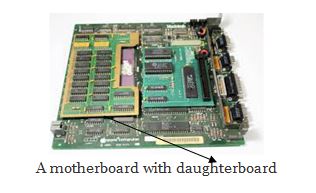Home »
Computer Basics
Daughterboard: An expansion to motherboard
In this article, we will learn about the Daughterboard - An expansion to motherboard. We will learn Daughterboard’s definition, what is it and when, by whom it was designed.
Submitted by Shamikh Faraz, on June 04, 2018

A daughterboard is a circuit board that plugs into and extends the circuitry of the main board called motherboard. A daughterboard is connected directly to the motherboard. Unlike expansion cards, which connect with the motherboard using the bus and other serial interfaces, daughterboards are usually directly embedded through soldering. Like a motherboard, a daughterboard has sockets, pins, plugs, and connectors to be attached to other boards. Typically, daughterboards are released as a post-launch update to a motherboard or expansion card. For example, a MIDI daughterboard is used to add on the functionality of the sound card. Modern computers rarely have daughterboards. In the past, this was common.
The earliest microcomputers were made up of different circuit boards, each of which performed a different function. All of these circuit boards were attached to a single board which is designed for some power regulation circuitry and a group of connectors. This board was commonly called a “bus board” or “backplane.”
In 1976, Steve Wozniak demonstrated to the Homebrew Computer Club his newly designed computer which had a single circuit board that had nearly all the functions needed for an entire computer. His computer design became known as the Apple 1. This single board, which was the first” motherboard” held the power regulation circuitry, a microprocessor, RAM, ROM, display circuitry, and a keyboard interface. Advance examples of daughterboards include the common memory modules used in our computers and Trusted Platform Modules.
Ref: Daughterboard
Advertisement
Advertisement